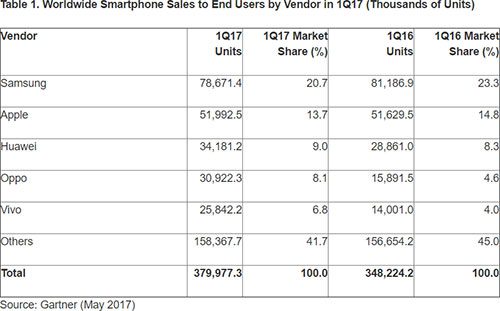Samsung and Apple, watch out.
Gartner’s latest global smartphone market data is out, and the figures indicate that Chinese smartphone manufacturers are making major gains at the expense of market leaders Samsung and Apple. All told, the world’s smartphone makers shipped 380 million units in the first quarter (Q1) of 2017, a nine percent year-over-year increase.
Samsung remains the smartphone vendors to beat, with 78.7 million units shipped in Q1 and a 20.7-percent share of the market. For comparison’s sake, the South Korean electronics giant shipped 81 million smartphones during the same quarter last year and claimed over 23 percent of the market.

“Although Samsung announced that preorders for the Galaxy S8 and S8 Plus are up 30 percent year over year, the absence of an alternative to Note 7 and the fierce competition in the basic smartphone segment are leading Samsung to continuously lose market share,” noted Gartner research director Anshul Gupta in a statement.
Second-place Apple saw its iPhone shipments rise slightly to nearly 52 million units from 51.6 million a year ago. Despite this, its share of the smartphone market dipped to 13.7 percent in Q1 2016 from 14.8 percent during the same quarter in 2016.
“Sales of iPhones were flat, which led to a drop in market share year over year,” Gupta stated. “Similar to Samsung, Apple is increasingly facing fierce competition from Chinese brands Oppo and Vivo, among others, and its performance in China is under attack.”
And those brands are gaining quickly on the current market leaders.
Huawei shipped 34 million smartphones in Q1 2017, up from almost 29 million a year ago and enough to nab nine percent of the market. Oppo’s shipments totaled nearly 31 million, a staggering 94.6-percent increase in just one year. The company’s focus on producing fast-charging phones with high-quality cameras, along with a selling strategy that hinges on physical retailers, is working well for the Chinese phone maker, noted Gupta.
Finally, Vivo shipped 25.8 million smartphones during the quarter, up from 14 million in Q1 2016. The company is doing brisk business by delivering high-quality devices to emerging markets, particularly in the Asia-Pacific region.
Meanwhile, Android’s dominance of the smartphone operating system market continues.
Google’s system software ran on 86.1 percent of all smartphones shipped in Q1 2017, or 327 million units. Apple iOS is a distant second with 13.7 percent of the market or nearly 52 million iPhones. The remaining smartphone operating systems clung to a sliver of the market (0.2 percent) on shipments of 821,200 devices.
Pedro Hernandez is a contributing editor at Datamation. Follow him on Twitter @ecoINSITE.
Ethics and Artificial Intelligence: Driving Greater Equality
FEATURE | By James Maguire,
December 16, 2020
AI vs. Machine Learning vs. Deep Learning
FEATURE | By Cynthia Harvey,
December 11, 2020
Huawei’s AI Update: Things Are Moving Faster Than We Think
FEATURE | By Rob Enderle,
December 04, 2020
Keeping Machine Learning Algorithms Honest in the ‘Ethics-First’ Era
ARTIFICIAL INTELLIGENCE | By Guest Author,
November 18, 2020
Key Trends in Chatbots and RPA
FEATURE | By Guest Author,
November 10, 2020
FEATURE | By Samuel Greengard,
November 05, 2020
ARTIFICIAL INTELLIGENCE | By Guest Author,
November 02, 2020
How Intel’s Work With Autonomous Cars Could Redefine General Purpose AI
ARTIFICIAL INTELLIGENCE | By Rob Enderle,
October 29, 2020
Dell Technologies World: Weaving Together Human And Machine Interaction For AI And Robotics
ARTIFICIAL INTELLIGENCE | By Rob Enderle,
October 23, 2020
The Super Moderator, or How IBM Project Debater Could Save Social Media
FEATURE | By Rob Enderle,
October 16, 2020
FEATURE | By Cynthia Harvey,
October 07, 2020
ARTIFICIAL INTELLIGENCE | By Guest Author,
October 05, 2020
CIOs Discuss the Promise of AI and Data Science
FEATURE | By Guest Author,
September 25, 2020
Microsoft Is Building An AI Product That Could Predict The Future
FEATURE | By Rob Enderle,
September 25, 2020
Top 10 Machine Learning Companies 2021
FEATURE | By Cynthia Harvey,
September 22, 2020
NVIDIA and ARM: Massively Changing The AI Landscape
ARTIFICIAL INTELLIGENCE | By Rob Enderle,
September 18, 2020
Continuous Intelligence: Expert Discussion [Video and Podcast]
ARTIFICIAL INTELLIGENCE | By James Maguire,
September 14, 2020
Artificial Intelligence: Governance and Ethics [Video]
ARTIFICIAL INTELLIGENCE | By James Maguire,
September 13, 2020
IBM Watson At The US Open: Showcasing The Power Of A Mature Enterprise-Class AI
FEATURE | By Rob Enderle,
September 11, 2020
Artificial Intelligence: Perception vs. Reality
FEATURE | By James Maguire,
September 09, 2020

Datamation is the leading industry resource for B2B data professionals and technology buyers. Datamation's focus is on providing insight into the latest trends and innovation in AI, data security, big data, and more, along with in-depth product recommendations and comparisons. More than 1.7M users gain insight and guidance from Datamation every year.
Advertise with TechnologyAdvice on Datamation and our other data and technology-focused platforms.
Advertise with Us
Property of TechnologyAdvice.
© 2025 TechnologyAdvice. All Rights Reserved
Advertiser Disclosure: Some of the products that appear on this
site are from companies from which TechnologyAdvice receives
compensation. This compensation may impact how and where products
appear on this site including, for example, the order in which
they appear. TechnologyAdvice does not include all companies
or all types of products available in the marketplace.